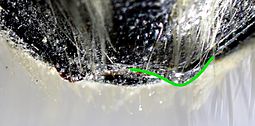Banded brush beetle
| Banded brush beetle | ||||||||||||
|---|---|---|---|---|---|---|---|---|---|---|---|---|

Banded brush beetle on a devil's bite |
||||||||||||
| Systematics | ||||||||||||
|
||||||||||||
| Scientific name | ||||||||||||
| Trichius fasciatus | ||||||||||||
| ( Linnaeus , 1758) |
|
Fig. 1: ♂ Mesotibia |
Fig. 2: ♂ 1st tarsal link |
Fig. 3: ♀ 1st tarsal link |

|
||
|
Fig. 4: ♀, end of the pygidium, top view of the right edge traced in green |
||

|
||
| Fig. 5: ♂, side view | ||
The banded brush beetle ( Trichius fasciatus ) is a beetle from the family of scarab beetles (Scarabaeidae).
features
The banded brush beetle is 9 to 12 mm long. The black markings on the light yellow to deep orange elytra can vary widely. The rest of the body is covered with yellow and white woolly hair. This makes it look a bit like a bumblebee, which gives it better protection from predators.
The distinction between the three European species of the genus (in addition to Trichius fasciatus , the Trichius sexualis and Trichius gallicus ) is made separately for males and females. These can be easily distinguished in all species on the front leg. In the female (Fig. 3) the splint is wide, the external teeth are strong - typical of the tombstone. The first tarsal link is small and only slightly protrudes from the tip of the end tooth. In the male (Fig. 2) the splint is narrow and the grave teeth are weaker. The first tarsal phalanx clearly protrudes beyond the end tooth and is thickened on the outside. Only the males of Trichius fasciatus have a strong transverse ridge, which ends in a tooth, about halfway up the central splint (mesotibia) (Fig. 1). In the other species this ridge is only weakly developed, one tooth is missing. The females of Trichius fasciatus, on the other hand, differ from the other species in the construction of the pygidium . This does not end rounded, but rather indented (Fig. 4).
Occurrence
The beetle is common in some areas in forest clearings in the mountains, but rarely found in the lowlands. It lives mostly on flowers in forest meadows and forest edges.
food
The finished beetles feed on the pollen of various flower-bearing plants. These include umbellifers , roses and thistles . Blackberry bushes are also regularly flown to. The larvae ( grubs ) feed mainly on dead wood and other organic plant parts.
Way of life
The larvae develop in decaying wood from various deciduous trees. In June and July the beetle mainly visits umbellate flowers and feeds on pollen there. Roses, blackberry blossoms and thyme are also popular .
literature
- Svatopluk Bílý, Alena Čepická: beetles . Artia Publishing House, Prague 1990, ISBN 3-7684-2929-6 .
- Michael Chinery: Parey's Book of Insects. A field guide of European insects. Paul Parey Publishing House, Hamburg / Berlin 2004, ISBN 3-440-09969-5 .
- Bernhard Klausnitzer : Beetle . Nikol Verlagsgesellschaft, Hamburg 2005, ISBN 3-937872-15-9 .
- Jiři Zahradnik et al .: Beetles of Central and Northwestern Europe. Parey, Berlin 1985, ISBN 3-490-27118-1 .
Web links
- Trichius fasciatus in Fauna Europaea (English)
- Brush beetle on Natur-Lexikon.com
- Pictures Trichius fasciatus (private website)


